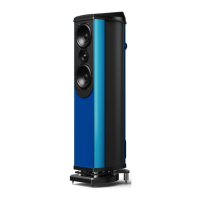FIBONACCI SERIES MANUAL REV 1.0
6
2.0 The Subject of Room Acoustics
Acoustics is a complex subject and this text should be treated for what it is -- a simple but informative guide. For a deeper understanding we would recommend seeking out
a range of texts on the subject which can be used in conjunction with basic measurement equipment such as a tape measure, laser measure and spirit level.
It is important to respect the role that the room and its contents will have on the overall sound of the audio system. The air contained within the room is the link between
the output of the loudspeaker and your ear. How this air behaves is dependent upon the attributes or character of the room. It follows that a better understanding of basic
acoustics will assist in making decisions about the way in which the room and subsequently the system can be initially installed and ultimately improved. We strongly
recommend that customers have your Wilson Benesch dealer do the nal voicing and positioning of your Wilson Benesch loudspeaker with you.
Room types fall between two extremes. A room can be ‘dead’ -- being full of highly acoustic energy absorbent materials. Or a room may be ‘lively’ -- with a high
proportion of non-absorbent, hard, reective surfaces. A combination of materials with different acoustic properties will in general allow the listener to achieve a balance
between these extremes, which is of course preferable to either extreme at which point the performance and accuracy of the music’s presentation will suffer.
The contents of a room will impact upon its overall acoustic character. As you would expect harder surfaces like glass, concrete or wooden oors tend to reect and/or
diffuse a broad band of acoustic energy. Complimentary materials that are soft and thick such as heavy natural bre curtains, large rugs or soft acoustic panels will tend
to absorb a broad band of frequencies.
2.1 Standing waves
When sound waves reect between two parallel surfaces, the distance apart being equal to half the wavelength or less, dependent upon wave size, resonance modes
referred to as ‘standing waves’ are created. In loudspeakers with parallel walls these waves will cause distortions. The standing waves in your room will distort the
frequency response of your system sympathetically boosting or cancelling certain frequencies. If a certain standing wave frequency is acoustically isolated from its modal
neighbours its effect is more likely to be audible and problematic. This can compromise the accuracy of the presentation of any loudspeaker.

